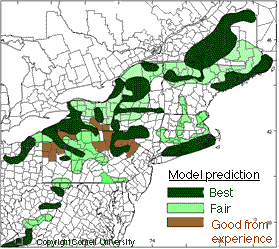Where to Grow Buckwheat
Certain parts of the Northeast have the proper climate to grow buckwheat. These are places where the summer evenings are cool, but frost comes relatively late in the fall. These areas are at higher elevations in New York, Pennsylvania, Maryland, and West Virginia. There are also good areas near Lake Erie, Lake Ontario, and the Finger Lakes in New York, Pennsylvania, Ohio, and Ontario. Finally, there are cool regions in Maine that are well-suited. See the map at the bottom of this page.
Land that has not been planted to spring-seeded crops is available to buckwheat. Perhaps you have more land than you can prepare and plant. Sometimes there is land available where another crop has failed. Buckwheat may also fit into a rotation as a second crop after early crops that are harvested in June or early July, such as lettuce, peas, rye straw, or barley. In Ohio, no-till buckwheat can follow wheat in some years.
Land that is unsuitable for other crops can be improved with buckwheat. Buckwheat farming earned a bad reputation in the last century because impoverished farmers on marginal land could grow only buckwheat for food and fodder. Today, most of this land is out of production. Even today, the ability of buckwheat to grow on low-fertility land can be useful. It is a good first crop on land being brought back into production. It is also good on soils that dry slowly in the spring (but are otherwise well-drained). Although buckwheat is useful in these situations, it is not a good practice to grow buckwheat on soils that are best suited for pasture or forest.
Buckwheat growing regions in the Northeast USA

Click on the map for a larger image.
The above map is based on a climatological model for both avoiding heat injury to flowers at bloom and avoiding killing frost during the growing season. Water stress and fertility are not considered. Some additional growing areas are in brown.
